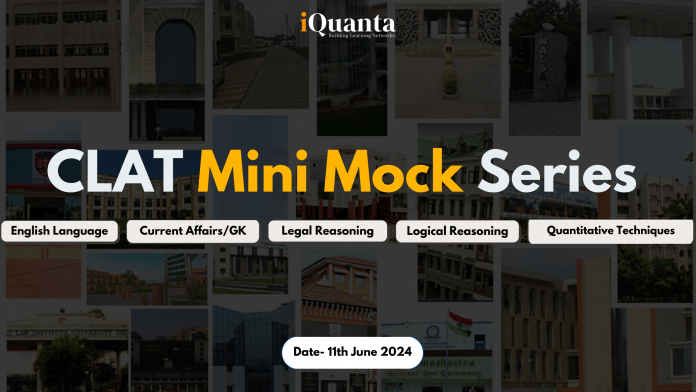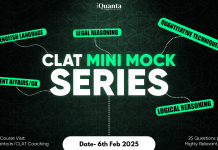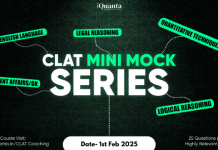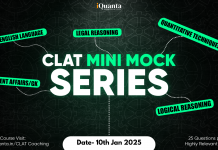iQuanta has launched a Mini Mock Series covering all the sections of the CLAT exam, these questions have been handpicked b y our faculty based on the latest CLAT exam pattern.
Instructions:-
1. Attempt all the questions.
2. Once you have completed all the questions of a particular section click on the submit button for scores and explanations then move to the next sections.
3. For each correct answer, you receive 1 mark. For this mock, there is no negative marking.
English Language
Directions: Read the passage and answer the following question.
What the gene story tells us is that there are good reasons behind the patterns we see on India’s sociological map and for the differing answers given to common questions of our civilisation, including what to eat and what not to eat. To try to erase these differences and patterns to create a monoculture would be a typically un-Indian enterprise, prone to mishaps and doomed to failure.
One reason for the continuing and doomed attempt to force-fit an artificial uniformity on Indian culture is the way our history is written, often with justification. Until now, it made sense for history books to begin at that point in time when records became available and to ignore the earlier parts or, at most, dismiss them in a few paragraphs or pages. In India, this meant that everyone began to consider the beginning of our history to be around 4,500 years ago, when the Harappan Civilisation reached its mature stage, or perhaps when the Vedas were composed centuries later. This was understandable because until recently there was no easy way of confirming what went on in prehistory and all that anyone could do was make intelligent guesses. But this is rapidly changing, in India and elsewhere, thanks to ancient DNA. As more and more of it is accessed and analysed all across Eurasia, we are gaining a more granular understanding of our own prehistory and the time has come to begin writing our history from where it should begin. History, if it is to be undistorted and connected with the people of the country, should be built the right side up: starting with the base, the foundation of our population today, the First Indians.
This shouldn’t be difficult. The genius of our civilisation, during its best periods, has been inclusion, not exclusion. The Harappan Civilizsation was built by a population with the shared ancestry of First Indians and the early agriculturists of the Zagros region in Iran. When Buddhist missionaries first carried India’s cultural ethos beyond its borders to China, south-east Asia and central Asia, it was driven by a missionary zeal that was global and all-encompassing, without discrimination of caste, creed or race. It drew its principles and practices from all parts of India’s previous history including that of the ‘Aryans’, even while challenging rituals, sacrificial practices and ideas of hierarchy. It was, therefore, natural that Buddhism became the first philosophy in the world that felt the burning desire to share its insights and message of compassion with all humans, without regard for man-made or natural borders.
Current Affairs and General Knowledge
Directions: Read the passage and answer the following question.
Supreme Court has said that the Constitution is silent on criteria for granting promotion to govt servants and ruled that the legislature and executive are free to decide the norms for promotion keeping in view the nature, functions and requirements of a promotional post.
A bench of CJI D Y Chandrachud and Justices J B Pardiwala and Manoj Misra in a recent judgment said, “In India, no govt servant can claim promotion as their right because Constitution does not prescribe criteria for filling seats in promotional posts.
The legislature or the executive may decide the method for filling vacancies to promotional posts based on the nature of employment and the functions that the candidate will be expected to discharge.”
Legal Reasoning
Directions: Read the passage and answer the following question.
The Negotiable Instruments (Amendment) Bill, 2017 was introduced in Lok Sabha on January 2, 2018. It seeks to amend the Negotiable Instruments Act, 1881. Negotiable instruments are documents which promise payment to the assignee (the person whom it is assigned to/given to) or a specified person. These instruments are transferable signed documents which promise to pay the bearer/holder the sum of money when demanded or at any time in the future. The final holder takes the funds and can use them as per his requirements. That means, once an instrument is transferred, holder of such instrument obtains a full legal title to such instrument.
The Act defines promissory notes, bills of exchange, and cheques. It also specifies penalties for bouncing of cheques, and other violations with respect to such negotiable instruments. Cheque bouncing is considered to be a grave offence which is not excusable.
A promissory note refers to a written promise to its holder by an entity or an individual to pay a certain sum of money by a pre-decided date. Promissory notes show the amount which someone owes to you or you owe to someone together with the interest rate and also the date of payment.
The promissory note must be in writing. The object of this requirement is to exclude oral engagements to pay from the purview of the Act, mere verbal engagement to pay is not enough. The instrument must contain an express promise to pay. The promise to pay must be definite and unconditional. If it is uncertain or conditional, the instrument is invalid. The instrument must point out with certainty as to who the maker is and who the payee is. When the maker and the payee cannot be identified with certainty from the instrument itself, the instrument, even if it contains an unconditional promise to pay, is not a promissory note. The sum payable must be certain and must not be capable of contingent additions or subtractions.
The payment must be in the legal tender money of India.
[Extracted, with edits and revisions, from negotiable-instruments, article by cleartax]
Logical Reasoning
Directions: Read the passage and answer the following question.
For a game that has existed for almost two centuries, cricket never had a proper grading system till the 1975 Prudential World Cup. It was an experiment, a format devised in 1971 when an Ashes Test was nearly washed out at the Melbourne Cricket Ground. The basics remained. Sixty overs a side with the Dukes ball, white flannels, white sight screens in day games that had to finish before sunset — one-dayers were adaptations of Test matches. Coloured clothing, white Kookaburra, and floodlights made an entrance in the 1992 World Cup.
Since then, every World Cup marked the evolution of the game. Nearly 50 years into the cricket World Cup, there are vast tracts of fond remembrance despite the dipping primacy of international cricket. Imran Khan’s return from retirement to lead Pakistan to their only World Cup win was the boost subcontinent cricket needed after India’s 1983 triumph. Sri Lanka joined that league four years later, leading to a rush among nations to compete. Bangladesh and Afghanistan entered, and perhaps, Nepal soon.
The game evolved. Spinners began opening the bowling, middle overs became more productive, more sixes were hit, wrist spinners rose to prominence, and preserving wickets for a slog-overs dash became essential. Records tumbled. When Viv Richards scored 181 against Sri Lanka in the 1987 World Cup, no one thought it could be broken soon. That record stood for eight years. The 2019 World Cup saw a tied final decided on boundary count. Each World Cup edition gave us new ways to appreciate and love cricket.
The T20 format brought significant changes, but without the ODI World Cup, cricket wouldn’t have achieved global recognition. What distinguishes a legendary team from the greatest sides? Traditionalists value Test accomplishments — unbeaten streaks, consecutive wins, and statistics that signify invincibility. But World Cup wins are equally significant. If a cricketer is expected to switch between formats, why can’t teams?
Australia and West Indies dominated the ODI scene for 40 years. Eleven Test wins in a row between March and November 1984 showcased West Indies’ ruthlessness. Their success spanned 15 years between 1980 and 1994 without a Test series loss. Factor in the World Cup wins in 1975, 1979, and the 1983 final, and we see a team that dominated both formats for two decades.
Quantitative Techniques
Directions: Read the passage and answer the following question.
COVID-19 pandemic turned life upside-down for many families across the world. Mr. Abhishek was working as a sale executive in a famous Marketing Company. Due to COVID19 pandemic lockdown and restrictions, Mr. Abhishek was not able to achieve his monthly targets which resulted in the reduction of his salary. So far, he spent his income lavishly without any planning and prior calculations. However, the prevailing situation compelled him to plan his expenditure to adjust his life to the present income. Therefore, he analysed his spendings of last year i.e., 2019, so that he can plan his present year 2020 spendings. Through his brief analysis, he found that in the year 2019, he spent 23 per cent of his income on food, 15 per cent on Housing, and 12 per cent on his child’s education. For his transport, he spent 10 per cent, and for clothing of his family he spent 10 per cent. In the meanwhile, Mr. Abishek also saved 15 per cent of his income in the year 2019, and the remaining 20 per cent of expenditure he kept as other spendings. Answer the following questions to provide deeper insight to Mr. Abhishek.




